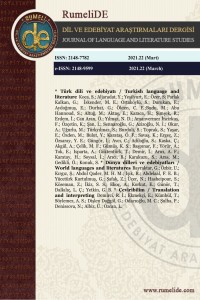Holokost’a geriden bakmak : Martin Amis’s Time’s Arrow
Abstract
Martin Amis, en büyük çağdaş İngiliz yazarları arasındadır. 1991 romanı Time's Arrow, korkunç bir olay olan Holokost hakkında ayrıntılı deneyimler sunan heyecan verici bir çalışmadır. Romandaki diyalog ters yönde gerçekleşir; bu nedenle okuyucu basit konuşmaları bile anlayabilmek için için okurken istekli olmalıdır. Martin Amis, Holokost'un 20. yüzyılın en önemli olayı olduğuna inanır. Time's Arrow, Holokost ile ilgili çalışan akademisyenlerin büyük ilgisini çekmektedir. Martin Amis’in, erken dönem çalışmalarında, soykırımla ilgili hikayedeki gibi aile içi sorunlar ve ciddi konularla ilgilendiğini görürüz. Time's Arrow'da da yine ciddi sorunları ele almakta, bu da onu popüler edebiyat konularından biri olan Holokost gibi bir olayı ele almak için bilgi sahibi ve hevesli bir kişi olduğunu göstermektedir. Amis'in zamanda geriye doğru hareketleri, sanki bir videoyu tersten oynatır gibi, kahramanın hayatını tersine ayrıntılı bir anlatımla açık ve kapsamlı bir şekilde sunmaktadır. Amis 'in romanda ortaya koyduğu gibi, Nazi mantığı, sıklıkla hasarları bir gelişme aracı olarak rasyonelleştirildiği için, yıkım ve yaratılış arasındaki çizgileri bulanıklaştırmıştır. Hikaye, soykırım cinayetinin ırksal bir yenilenmeye yol açacağına dair derin bir anlayış geliştirmeye çalışmaktadır. Çatışmanın, militarizmin kullanıldığı Almanya örneğinde olduğu gibi ulusal yenilenmeye yönelik bir yaklaşım olarak kullanılabileceğini göstermektedir. Bu makale, romanda Martin Amis'in sunduğu Holokost'u ve Time's Arrow'da kullanılan anlatım tekniklerini inceleyecektir.
Keywords
References
- Amis, M. (2003). Time’s Arrow. London: Vintage.
- Badrideen, A. (2018). The soul in Time’s Arrow: A post-Enlightenment presence. Journal of European Studies, 48(1), 56-68. https://doi.org/10.1177/0047244117744089
- Ben-Merre, D. (2013). After Words: The Paratexts of Martin Amis’s Time’s Arrow. The Explicator, 71(2), 117-119. https://doi.org/10.1080/00144940.2013.781004
- Diedrick, J. (2004). Understanding Martin Amis. Columbia: University of South Carolina Press.
- Harris, G. (1999). Men Giving Birth to New World Orders: Martin Amis’s Time’s Arrow. Studies in the Novel, 31(4), 489-505. https://www.jstor.org/stable/29533359
- James, A. (2020). Martin Amis. The Wiley Blackwell Companion to Contemporary British and Irish Literature, 241-253. London: John Wiley& Sons.
- López Alcázar, N. (2020). The Holocaust as zero-hours: reading and uncovering guilt through silences in Martin Amis’ Time’s Arrow (1991).
- Praisler, M. (2017). Hi, (s) story Gone Wrong. Martin Amis on the Holocaust in Time’s Arrow. Cultural Intertexts, 7, 177-189.
- Slater, M. (1993). Problems When Time Moves Backwards Martin Amis’s Time’s Arrow. English, 42(173), 141-152. https://doi.org/10.1093/english/42.173.141
- Van Wyk, K. (2015). Catastrophism and Time in Martin Amis’s Time’s Arrow. English Studies in Africa, 58(2), 80-89. https://doi.org/10.1080/00138398.2015.1083199
- Vice, S. (2003). Holocaust Fiction. London: Routledge....................
Looking Holocaust backwards : Martin Amis’s Time’s Arrow
Abstract
Martin Amis is one of the greatest contemporary British writers. His 1991 novel Time’s Arrow is an exciting work that gives detailed experiences about the horror event of the Holocaust. The dialogue in the novel occurs in reverse; thus, the reader should be keen when reading to understand simple conversations well. Martin Amis believes that the Holocaust is the central event of the 20th century. Time’s Arrow is of great interest to scholars of the Holocaust. In his early work, Martin Amis shows that he was interested in domestic issues and strict topics in the story about the Holocaust. Still, in Time’s Arrow, he handles serious problems, which portrayed him as an informative and enthusiastic person to address an event like the Holocaust, one of the popular literature platforms. Amis’s backward moves through time were presented clearly and comprehensively with a detailed account of the hero’s life in reverse, like playing a video in reverse mode. As Amis presented in the novel, the Nazi rationality blurred the lines between destruction and creation, as damages were frequently rationalized as a means to develop. The story brings a profound understanding that genocide killing will lead to racial renewal. It illustrates that conflict can be used as an approach towards national renewal as in the German case when it used militarism. This paper will explore the Holocaust presented by Martin Amis in the novel and the narrative techniques used in the Time’s Arrow.
References
- Amis, M. (2003). Time’s Arrow. London: Vintage.
- Badrideen, A. (2018). The soul in Time’s Arrow: A post-Enlightenment presence. Journal of European Studies, 48(1), 56-68. https://doi.org/10.1177/0047244117744089
- Ben-Merre, D. (2013). After Words: The Paratexts of Martin Amis’s Time’s Arrow. The Explicator, 71(2), 117-119. https://doi.org/10.1080/00144940.2013.781004
- Diedrick, J. (2004). Understanding Martin Amis. Columbia: University of South Carolina Press.
- Harris, G. (1999). Men Giving Birth to New World Orders: Martin Amis’s Time’s Arrow. Studies in the Novel, 31(4), 489-505. https://www.jstor.org/stable/29533359
- James, A. (2020). Martin Amis. The Wiley Blackwell Companion to Contemporary British and Irish Literature, 241-253. London: John Wiley& Sons.
- López Alcázar, N. (2020). The Holocaust as zero-hours: reading and uncovering guilt through silences in Martin Amis’ Time’s Arrow (1991).
- Praisler, M. (2017). Hi, (s) story Gone Wrong. Martin Amis on the Holocaust in Time’s Arrow. Cultural Intertexts, 7, 177-189.
- Slater, M. (1993). Problems When Time Moves Backwards Martin Amis’s Time’s Arrow. English, 42(173), 141-152. https://doi.org/10.1093/english/42.173.141
- Van Wyk, K. (2015). Catastrophism and Time in Martin Amis’s Time’s Arrow. English Studies in Africa, 58(2), 80-89. https://doi.org/10.1080/00138398.2015.1083199
- Vice, S. (2003). Holocaust Fiction. London: Routledge....................
Details
| Primary Language | English |
|---|---|
| Subjects | Linguistics |
| Journal Section | World languages, cultures and litertures |
| Authors | |
| Publication Date | March 21, 2021 |
| Published in Issue | Year 2021 Issue: 22 |

